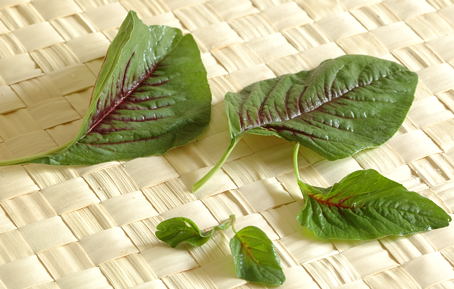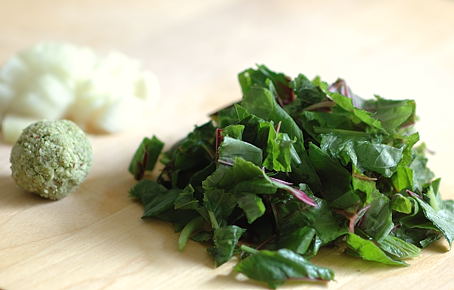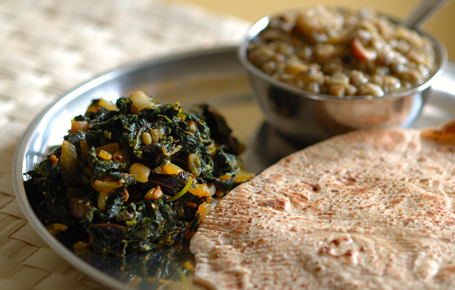
Fresh Amaranth (Thotakura) Leaves, In Different Stages of Development ~ for JFI-WBB: Greens
“The People of The World Shall Eat Amaranth” says a Richard Thomas and I agree.
Amaranth, like the temple Amarnath, has a devoted following. From India to Inca, amaranth is loved and praised for its nutritional benefits. If there is a vegetable valedictorian in green leafy vegetable world, then amaranth must be it. In our hometown, Nandyala in India, bunches of fresh amaranth leaves are a common sight at ritu bazaars (farmer markets) and sold under the name of Thotakura or Koyagura. Translation “garden leaf”. Just one seed is enough, amaranth spreads and makes the garden look vibrant with its beautiful red tinged-green leaves, so the name. Here, they are sold as Amaranth/Red Spinach/Chinese Spinach and available in most of the Indian and Southeast Asian grocery shops, during spring and early summer.
Amaranth (Thotakura) leaves start out green when they are tiny. As they grow, the red streak begins to appear and becomes prominent, almost covering the entire leaf in mature leaves. The leaves are stronger than regular spinach and on cooking do not ooze much water. The flavor of cooked amaranth leaves is more prominent and way better than that of spinach or other similar greens. Traditionally we prepare curries and also add the leaves to flavor dals. A quick stir fry, together with garlic, onions and green chilli-coconut powder is the popular method of cooking. And the curry is often served as a side dish to rice and dal, or chapati and dal. A cup of yogurt on the side makes this combination a complete meal for us.

Chopped Amaranth Leaves, Green Chilli-Coconut (Grinded and Shaped into a Round) and Onions
Recipe:
1. A bunch of fresh amaranth (thotakura), medium sized onion and garlic clove.
Pluck the leaves and tender stalks. Wash and drain. Finely chop the leaves, stalks and also onion and garlic to small pieces.
2. Four green chillies and a tablespoon of fresh or dried grated coconut.
Grind green chillies, coconut powder and a pinch of salt to fine consistency in a blender/spice grinder or in mortar with a pestle.
3. A teaspoon oil and quarter teaspoon each- urad dal, cumin & mustard seeds.
Heat oil in a wide skillet. Add and toast urad dal, cumin and mustard seeds, in that order.
4. Add garlic and onion. Stir fry to soft.
5. Add finely chopped leaves and stalks. Also, sprinkle green chilli-coconut powder and turmeric. On medium-high, cook until the leaves wilt. Sprinkle salt to taste and mix. Cook another couple of minutes and serve hot.

Amaranth (Thotakura) Curry with Chapati and Plantain Moong Dal
Fresh amaranth:
Nutritional Benefits
In Indian languages – Thotakura, Koyagura (Telugu), Cheera (Malayalam), Chaulli or Chowlii Chauli, Chavleri Sag (Hindi, Punjabi)
In Other languages – Red spinach, Rau Den, Chinese spinach, Hon-toi-moi, Yin choy, Eeen choy, Hsien tsai

This is one of my favorite greens. It’s just now starting to come into the stores, as it is a summer vegetable, so scarce in the winter. Every year I look forward to seeing its appearance.
Comment by Diane — April 16, 2007 @ 8:48 am
Indira,
What a coincidence! Over the weekend I cooked Brussels Sprouts with ginger and coconut. 🙂 Am planning to contribute that to JFI
Check it out here. http://ladybluemarble.blogspot.com/2007/04/brussels-sprouts-with-coconut-and.html
I love ginger and coconut combination very much. Great picture!
Comment by Vani — April 16, 2007 @ 8:51 am
A very nice and informative post…
Comment by sunita — April 16, 2007 @ 9:08 am
Hey Indira, I have a quick question. Do you find this leaf in the American stores? I havent seen it here until now, was just curious…
Comment by Deepika Saripalli — April 16, 2007 @ 9:51 am
Hi Indira
Interested in the hindi-punjabi name for Amaranth, I was just curious… I dont think it is called ‘Sag’… we call mustard greens Sag and we traditionally cook that with makki ki roti…. I never heard any other thing being called Sag, please clarify and correct me…
Hi Rachna, looks like the para gap created a confusion. They are not sag, they are called chavleri sag. I also added a link, please check it out if you are interested to know more.
I think sag is a generic term for green leaves and mustard is called sarson. I blogged a recipe called sarson ka saag, you can find out more details/links in that recipe.
Hope this helps.
Comment by Rachna — April 16, 2007 @ 10:44 am
that sure looks yummy
i like ur green chilli coconut taste
Comment by anusharaji — April 16, 2007 @ 12:11 pm
btw i like the points description rather than a whole para style
Comment by anusharaji — April 16, 2007 @ 12:13 pm
@deepika saripalli
i buy it from korean market hmart
i didnt come across it in american stores though
Comment by anusharaji — April 16, 2007 @ 12:15 pm
Chaulai+green chillies+coconut=bliss 🙂
Thanks Indira.
Comment by musical — April 16, 2007 @ 1:24 pm
nice recipe indira. we call it red cheera in kerala and i realy miss them in the U.S. now i just started growing them in my back yard..
u got a wonderful blog out here..thanks for the recipes.
Comment by maneka nirmal — April 16, 2007 @ 2:18 pm
Hmm, Wonder what it is called in Tamil! I’ve seen this Keerai, but don’t remember what it is called.
The greens look delicious.
Comment by Kay — April 16, 2007 @ 4:19 pm
Hello Indira
Thanks for a beautiful picture of such fresh “Thota kura” I have been here for 6 years but unfortunately havent seen thotakura yet…seeing your picture brought lovely memories. We cook thotakura stir fry with plain popu and chopped chillies and ginger or make pulusu of it. probably the best one for nutrition and people recovering from illness Thanks a million! Your website is true inspiration!
Comment by Aparna — April 16, 2007 @ 5:54 pm
Deepika: If you live anywhere near any Chinese or SE Asian markets, check them out. I can nearly always find it in Chinatown here in San Francisco/Oakland. In the conventional supermarkets or farmer’s markets in CA you can find it too, but less often.
Comment by Diane — April 16, 2007 @ 6:04 pm
Hi Indiragaru,
thanks for u r recipe it is very nice. i suggested u r site to my friend prasanna…. she also very happy … bcoz we both r from kurnool dt
Comment by vijaya — April 17, 2007 @ 1:37 am
Hi indira Garu,
Im a silent browser of yoursite for 1yr+ i ever commented nor posted anything But i refered your site to many of my friends and we all love it… esp the pictures etc
Keep up the good work!!
Madhuri
Dallas
Comment by madhuri — April 17, 2007 @ 10:04 am
This is something completely new to me. A must try for me. seems like this blog is going green now. this time in winter i planned to made winter -Green instead of pink winter :)) , i am glad to see greens here now .thanks for sharing. curry looks simple and healthy too .
-Pooja
Comment by Pooja — April 17, 2007 @ 6:45 pm
Hi Indira,
It looks yummy,will try this during weekend.we make thotakura podi kura with Moong daal or toor daal and my mom sometimes adds Vadiyalu in it.I like it with Gummadi vadiyalu.
I tried many of your recipies ,they taste so yummy
Cheers
Radhi
Comment by Radhi — April 18, 2007 @ 5:55 am
Hi Indira or India, great blog to be in. I had a wonderful time looking at the awesome pics n ur writing. Great! keep it up.
enjoy life as it unfolds…
Comment by raghu — April 18, 2007 @ 7:51 am
Hi,
It looks YUMMY, I am great fan of this green……I realy want to try this one…..
Comment by Sukanya — April 18, 2007 @ 2:27 pm
Hi
i love this green very much,In Tamil nadu we prepare this leaf part and stem part separately .the stem part we like most .we cook it with split moong dal,sambar onion,tomato,powder,stems(cut by small )ani seed powder ground coconut seasoned with mustard urad dal,curry leaves asafotida.
Comment by Aparna — April 18, 2007 @ 3:46 pm
Indira,
You have a great website and an awesome collection of recipes, needless to say with beautiful pictures and invaluable information. I am very fond of greens and w’d like to add it in my cooking as much.. I am not sure what it is called in tamil?? Can you pl let me know.. once again, gr8 website for all food lovers..
Comment by sripriya — April 18, 2007 @ 5:05 pm
It’s called mulaikeerai in Tamil.
Comment by Aparna — April 19, 2007 @ 9:36 am
i had all along thought ‘thotakura’ is unavailable here in the US. i hardly came across this in restaurant menus or any blogs, so thanks a ton indira for bringing to light the simple, yummy dishes these greens create. i now know where to look for it too.
Comment by Bharti — April 19, 2007 @ 10:46 am
Hi Indira,
Did u see eenadu today. They posted about the autors of “peddatha” and about their award. It is really great to see one of our cook book getting an award.
Laxmi.
Comment by laxmi — April 19, 2007 @ 7:49 pm
Ms.Indira,
Your site is excellent!!!Wonderful recepies and mouth watering pics
Comment by Santhi — June 20, 2007 @ 4:00 am
Indira,
photo at the following link , is that yours?
Just wanted to let you know if you have not already seen! (Or maybe they paid for this !)
http://item.slide.com/r/1/10/i/XraOsLBy1j-bynZRN1WOGOnKt2SRu9ge/
Comment by sv — January 25, 2008 @ 5:30 am
Dear Indira Garu,
Mee Site Superb andii.enjoying every bit of it
best regards
LBV PRASAD
Comment by L B V PRASAD — August 1, 2011 @ 7:16 am